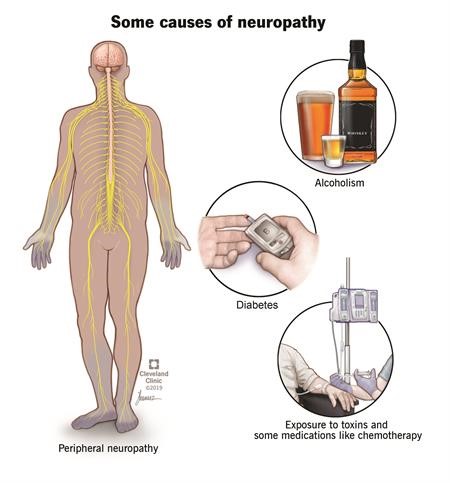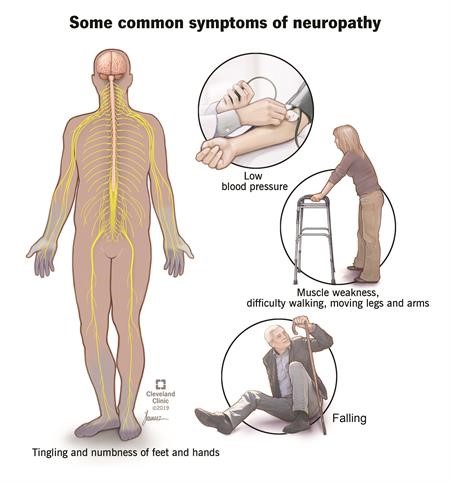Radiculopathy is caused by a pinched nerve in your spine. More specifically, it happens when one of your nerve roots (where your nerves join your spinal column) is compressed or irritated. You might see it referred to as radiculitis.
Radiculopathy will cause the area around your pinched nerve to feel painful, numb or tingly.
Depending on where along your spine the pinched nerve is, your healthcare provider will classify the radiculopathy as one of three types:
- Cervical radiculopathy (neck).
- Thoracic radiculopathy (upper middle back).
- Lumbar radiculopathy (low back).
Usually improving your posture, over-the-counter medicine or at-home physical therapy exercises are the only treatments you’ll need to relieve radiculopathy symptoms. In fact, some cases of radiculopathy improve with no treatment at all.
Radiculopathy vs. myelopathy
Both radiculopathy and myelopathy are painful conditions involving your spine. Radiculopathy is a temporary issue caused by a pinched nerve root near your spine. Myelopathy is compression of your spinal cord caused by a trauma, tumor, degenerative disease or infection.
If it’s not treated, myelopathy can worsen over time and cause permanent damage to your nerves. Radiculopathy is a temporary issue that heals over time and often goes away without treatment.
It can be hard to tell what’s causing your pain. That’s why it’s important to talk to your healthcare provider as soon as you notice any new symptoms — especially if they last more than a few days.
Radiculopathy vs. spondylolysis
Spondylolysis is a weakness at the point your vertebrae (the bones that make up your spine) connect together. This can lead to small stress fractures that cause pain, usually in your lower back. It usually affects teens going through growth spurts.
Radiculopathy can be caused by bones in your spine moving out of place, but symptoms like pain are caused when your nerve roots are compressed or irritated, and not by a broken bone.
Radiculopathy vs. sciatica
Both radiculopathy and sciatica are caused by pinched nerves.
The difference is which nerves are pinched causing the pain. Radiculopathy happens when a nerve along your spine is irritated or compressed. Sciatica is the pain or discomfort you feel when your sciatic nerve — the longest nerve in your body that starts in your lower back and runs down the back of each of your legs — gets compressed or pinched.
Radiculopathy usually hurts in the area of your back near the pinched nerve. Sciatica is a type of radiculopathy that causes pain along your sciatic nerve in your lower back and down your legs.
Who does radiculopathy affect?
Radiculopathy can affect anyone, but it’s more common in people older than 50.
How common is radiculopathy?
Radiculopathy is rare. While neck pain and back pain — especially lower back pain — are common problems, they’re rarely caused by radiculopathy.
How does radiculopathy affect my body?
The most obvious way radiculopathy affects your body is the pain and other symptoms it causes around your pinched nerve.
Depending on how severe your symptoms are — and which type of radiculopathy you have — it might be hard or uncomfortable to sit, stand or move. For example, if you have cervical radiculopathy, it might be painful and difficult to move your neck.
SYMPTOMS AND CAUSES
What are radiculopathy symptoms?
Symptoms of radiculopathy include:
- Pain in the area around your affected nerve.
- Tingling.
- Numbness.
- Muscle weakness.
Where you experience symptoms depends on which type of radiculopathy you have.
- Cervical radiculopathy: You might have pain and other symptoms in and around your neck, but these symptoms can radiate (spread out) to your arms and hands, too.
- Thoracic radiculopathy: You’ll likely have pain in and around your chest, including when you breathe in and out.
- Lumbar radiculopathy: The pain or numbness in your lower back can spread to your legs.
Some radiculopathy symptoms are similar to other, much more serious issues. Don’t ignore pain in your chest, trouble breathing or numbness in your limbs. Talk to your healthcare provider as soon as you notice these symptoms.
What causes radiculopathy?
Anything that compresses or irritates the roots of your spinal nerves can cause radiculopathy, including:
- Traumas like falls or car accidents.
- Bone spurs growing on one of your vertebrae.
- A herniated disc (also referred to as slipped, ruptured or bulging discs).
You can also develop radiculopathy with no direct cause other than getting older. As you age, your bones and the discs in your spine lose their shape and flexibility. This natural degeneration and weakening can cause your spine to shift enough to pinch a nerve.
DIAGNOSIS AND TESTS
How is radiculopathy diagnosed?
Your healthcare provider will diagnose radiculopathy with a physical exam and imaging tests. They’ll look at your back and spine, talk to you about your symptoms and ask about the different sensations you’re feeling.
You’ll probably need at least one of a few imaging tests, including:
- X-ray: An X-ray can show narrowing and changing alignment of your spinal cord, as well as any spinal fractures.
- Computed tomography (CT) scan: A CT scan shows 3D images and more detail of your spine than an X-ray can.
- Magnetic resonance imaging (MRI): An MRI can show if damage to soft tissues is causing the nerve compression. It will also show any damage to your spinal cord.
- Electromyography (EMG): An EMG measures electrical impulses in your muscles. This can help determine if a nerve is working as it should. This helps your healthcare provider know if your symptoms are caused by pressure on your spinal nerve roots or if another condition (like diabetes) damaged your nerves.
MANAGEMENT AND TREATMENT
How is radiculopathy treated?
Treatment depends on which type of radiculopathy you have (where the pinched nerve is along your spine) and how severe your symptoms are. Some people never need formal treatment if their symptoms improve on their own in a few days or weeks.
If you do need treatment, it might include some or all of the following:
- Ice or heat: Your healthcare provider will tell you how often to ice or apply heat to your back to reduce swelling or relax tight muscles.
- Adjusting your posture or physical therapy: Stretches and exercises that target the area around your spine can help ease pressure on your nerves and relieve pain. Improving your overall posture can help reduce stress on your spine and relieve your symptoms. Your healthcare provider or physical therapist will advise you on which types of exercises are best for the type of radiculopathy you have.
Radiculopathy surgery
It’s rare to need surgery to treat radiculopathy. Your healthcare provider will likely only recommend surgery if you have severe symptoms that affect your quality of life and don’t respond to other treatments. They’ll tell you which type of surgery you’ll need and what to expect.
How do I manage my radiculopathy symptoms?
Talk to your healthcare provider or physical therapist about how you can adjust your posture to make your daily routine more comfortable. They’ll recommend how you can comfortably sit, stand and sleep without aggravating your radiculopathy.
If your healthcare provider or physical therapist shows you stretches or exercises to strengthen your core muscles, try to do them as often as they recommend.
Don’t force yourself to do anything that hurts while you’re recovering, though. It might make your symptoms worse. Talk to your healthcare provider or physical therapist if the exercises they provide you are painful. They’ll tell you how to work through them safely.
How soon after treatment will I feel better?
You should feel better over time as you start treating radiculopathy symptoms. Some people feel better in a few days, but sometimes it takes a few weeks.
PREVENTION
How can I prevent radiculopathy?
Many of the causes of radiculopathy can’t be prevented. Maintaining good spine health and posture can help prevent some of the degeneration that can lead to radiculopathy.
OUTLOOK / PROGNOSIS
What can I expect if I have radiculopathy?
You should expect to make a full recovery from an episode of radiculopathy. It can be very painful and inconvenient, but it’s usually a temporary condition.
How long does radiculopathy last?
It depends on what caused your radiculopathy, and which type you’re experiencing. In general, most people feel better in a few weeks (or sooner). It might be longer if you have severe symptoms or other conditions that affect your spine.
Will I have to miss work or school?
If you can do your job or schoolwork without aggravating your symptoms, you shouldn’t have to miss work or school while you’re recovering from radiculopathy. Talk to your healthcare provider before resuming any physical activities.
Almost everyone experiences back pain at some point in their lives. There’s a difference between occasional aches and pains and a painful condition like radiculopathy, though. It can be scary to hear that something is wrong near your spine, but all forms of radiculopathy are very treatable and very rarely require surgery. You should make a full recovery with at-home treatments and by giving your body time to heal.


